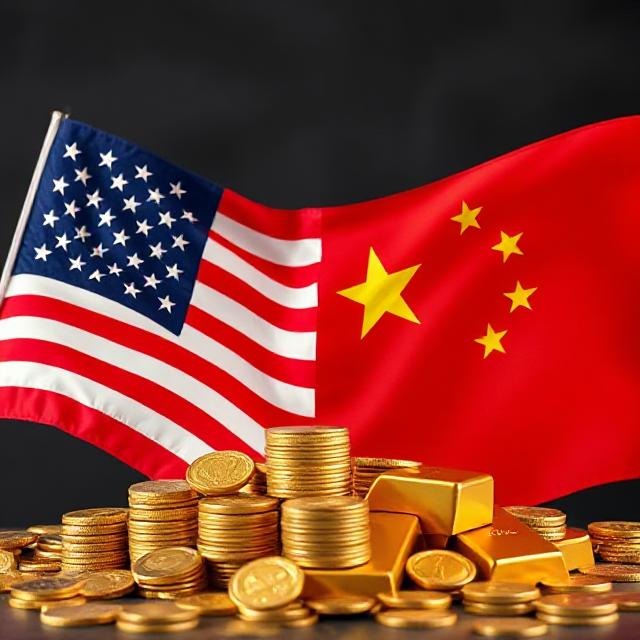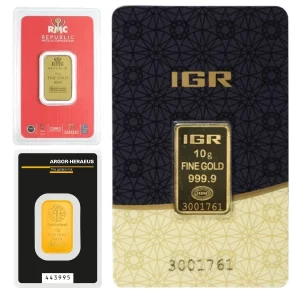Welcome to this week’s newsletter, where we unravel the escalating U.S.-China trade war and its ripple effects on global markets, sparking a wave of gold repatriation around the world and pushing gold prices to a historic high of over $3,200 per ounce. As nations scramble to safeguard their wealth amid fears of economic fallout, the glittering allure of gold has never been stronger.
The U.S.-China Trade War: A Timeline of Fearful Escalation
The U.S.-China trade war, which began in 2018, has reached unprecedented heights in 2025, stoking global anxiety over economic stability. It all started when the U.S., under President Donald Trump, imposed tariffs of 30–50% on solar panels and washing machines in January 2018, targeting Chinese imports. China retaliated swiftly, hitting U.S. goods like pork and steel pipes with tariffs by April of 2018. The tit-for-tat escalated through 2018 and 2019, with the U.S. slapping 25% tariffs on $50 billion USD of Chinese goods, followed by 10–25% tariffs on $200 billion USD more, while China countered with tariffs on U.S. soybeans, autos, and energy products worth $60–75 billion USD.
A brief respite came with the 2020 Phase One trade deal, which paused further escalation, but commitments faltered, and tensions reignited. By 2024, the Biden administration added targeted tariffs—100% on Chinese electric vehicles, 50% on solar cells—while maintaining Trump-era levies. The real shock arrived in 2025, as Trump’s second term unleashed sweeping measures. On February 1st, 2025, a 10% tariff hit all Chinese imports, rising to 20% by March. Dubbed “Liberation Day,” April 2nd, 2025, saw U.S. tariffs on Chinese goods soar to 54%, and by April 9th, 2025, an astronomical 145% tariff rate was announced. China matched this aggression, imposing 34% tariffs on all U.S. imports by April 10th, 2025, averaging 125%, alongside export controls on rare earths and restrictions on U.S. firms like Google.
This relentless trade war has rattled markets, disrupted supply chains, and fueled fears of a global economic downturn. Businesses face soaring costs, consumers brace for higher prices, and nations worry about collateral damage. The specter of sanctions, vividly demonstrated by the 2022 freezing of Russia’s $640 billion USD in reserves, has deepened distrust in Western financial systems, prompting a dramatic shift: countries are rushing to bring their gold home.
Gold Repatriation: A Global Dash for Security
Since 2020, nations worldwide have accelerated efforts to repatriate gold reserves, driven by fear that trade wars and sanctions could jeopardize assets stored abroad. The U.S.-China trade conflict, with its potential to destabilize currencies and economies, has made gold—a timeless safe haven—more critical than ever.
Poland continued its repatriation, securing gold from the Bank of England to bolster economic sovereignty.
Hungary increased domestic holdings post-2020, citing geopolitical risks.
Romania advanced plans to bring back 91.5% of its gold from the UK, emphasizing national pride.
India made headlines in 2024, repatriating 100 tons from London to shield against sanctions risks.
Nigeria, Ghana, and Cameroon joined the trend in 2024, moving billions in gold and reserves from the U.S., wary of asset freezes.
South Africa, Egypt, and Saudi Arabia began shifting gold from New York and London, diversifying amid U.S.-China frictions.
Serbia and Slovakia pushed for repatriation, with Slovakia citing historical distrust in foreign custodians.
Then, a striking development emerged in early 2025: Germany, which previously repatriated 674 tonnes by 2020, expressed renewed urgency to bring home its remaining 1,200 tonnes from the U.S. Federal Reserve, valued at €113 billion. Senior Christian Democratic Union of Germany politicians, rattled by U.S. tariff threats and trade war fallout, have called for audits or full repatriation, fearing exposure to geopolitical shocks. While the Bundesbank remains confident in U.S. storage, the debate underscores a broader anxiety gripping nations.
The 2022 Russian sanctions were a wake-up call, proving that foreign-held assets could be weaponized overnight. As U.S.-China tariffs spiral, countries fear their gold—often stored in New York or London—could become leverage in a broader economic conflict. Repatriation is no longer just logistical; it’s a strategic move to reclaim control in a world where trust is eroding.
Gold Prices Smash Records: $3,200 and Climbing
Amid this chaos, gold has cemented its status as the ultimate hedge against uncertainty. At time of writing, gold prices are shattering records, crossing $3,200 per ounce for the first time in history, and currently sitting at $3236.70 USD/oz up 1.95% on the day. This surge reflects surging demand as investors, central banks, and nations flee volatile markets and fiat currencies that face swift erosion. The U.S.-China trade war, with its threat of inflation, supply chain disruptions, and currency devaluation, has supercharged gold’s appeal.
Central banks, particularly in emerging markets, have been net buyers of gold since 2020, with India, Poland, and Hungary leading purchases. The repatriation wave has further tightened supply, as nations hoard physical gold rather than leaving it in foreign vaults. Meanwhile, fears of a U.S. dollar weakened by trade deficits and sanctions backlash have pushed investors toward gold’s stability. And this is in no way meant to write off silver as a means of financial protection. We recently wrote in our previous newsletter that with a gold to silver ration near 100, silver is poised for a big move. On cue, silver is up 10.55% over the past 5 days, showing no signs of slowing down, and currently sits at $32.12 USD/oz.
Why Gold? Why Now?
The U.S.-China trade war isn’t just about tariffs—it’s a proxy for deeper fears about global economic order. Tariffs averaging 145% on Chinese goods and 125% on U.S. imports signal a breakdown in cooperation, threatening growth and stability. For countries watching their exports and currencies hang in the balance, gold offers a tangible anchor, immune to sanctions or digital freezes if held at home.
Repatriation reflects this paranoia. When Nigeria moved $35.5 billion in assets, including gold, from the U.S., or when India hauled 100 tons back from London, it wasn’t just logistics—it was a vote of no confidence in a fracturing system. Germany’s push for its 1,200 tonnes underscores even traditional U.S. allies are hedging bets. A grim sign of what is to come.
As the trade war rages, expect more nations to join the repatriation race, further driving higher gold prices. The $3,200 milestone may soon look modest if tariffs escalate or sanctions expand. For investors, gold remains a beacon in the storm, but for policymakers, it’s a warning: unchecked trade conflicts could reshape global finance in ways no one can fully predict.
 Hi,
Hi,












